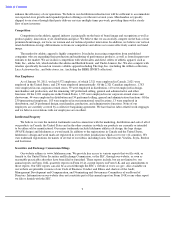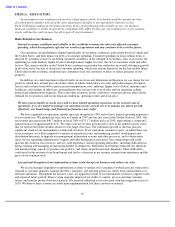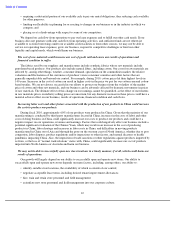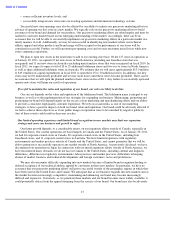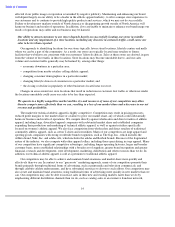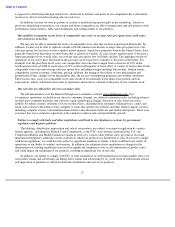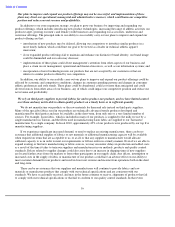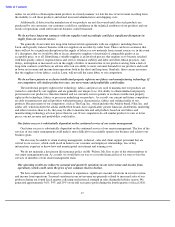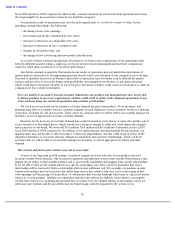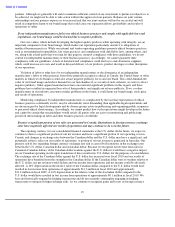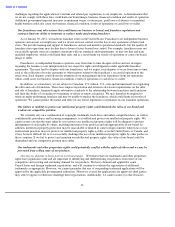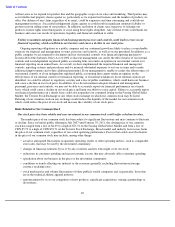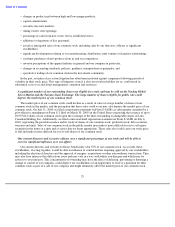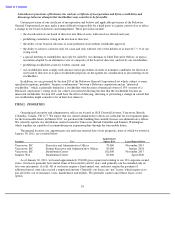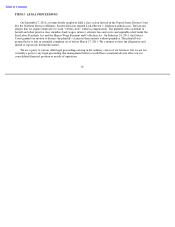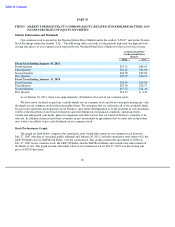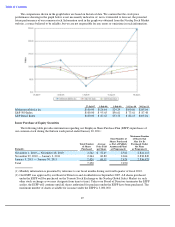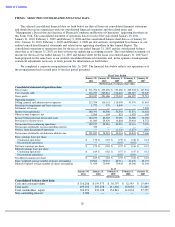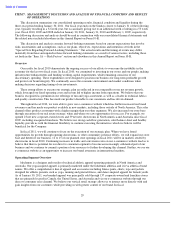Lululemon 2010 Annual Report Download - page 24
Download and view the complete annual report
Please find page 24 of the 2010 Lululemon annual report below. You can navigate through the pages in the report by either clicking on the pages listed below, or by using the keyword search tool below to find specific information within the annual report.
Table of Contents
partners. Although we generally will seek to maintain sufficient control of any investment to permit our objectives to
be achieved, we might not be able to take action without the approval of our partners. Reliance on joint venture
relationships and our partners exposes us to increased risk that our joint ventures will not be successful and will
result in competitive harm to our brand image that could cause our expansion efforts, profitability and results of
operations to suffer.
If our independent manufacturers fail to use ethical business practices and comply with applicable laws and
regulations, our brand image could be harmed due to negative publicity.
Our core values, which include developing the highest quality products while operating with integrity, are an
important component of our brand image, which makes our reputation particularly sensitive to allegations of
unethical business practices. While our internal and vendor operating guidelines promote ethical business practices
such as environmental responsibility, fair wage practices, and compliance with child labor laws, among others, and
we, along with a third-party that we retain for this purpose, monitor compliance with those guidelines, we do not
control our independent manufacturers or their business practices. Accordingly, we cannot guarantee their
compliance with our guidelines. A lack of demonstrated compliance could lead us to seek alternative suppliers,
which could increase our costs and result in delayed delivery of our products, product shortages or other disruptions
of our operations.
Violation of labor or other laws by our independent manufacturers or the divergence of an independent
manufacturer’s labor or other practices from those generally accepted as ethical in Canada, the United States or other
markets in which we do business could also attract negative publicity for us and our brand. This could diminish the
value of our brand image and reduce demand for our merchandise if, as a result of such violation, we were to attract
negative publicity. Other apparel manufacturers have encountered significant problems in this regard, and these
problems have resulted in organized boycotts of their products and significant adverse publicity. If we, or other
manufacturers in our industry, encounter similar problems in the future, it could harm our brand image, stock price
and results of operations.
Monitoring compliance by independent manufacturers is complicated by the fact that expectations of ethical
business practices continually evolve, may be substantially more demanding than applicable legal requirements and
are driven in part by legal developments and by diverse groups active in publicizing and organizing public responses
to perceived ethical shortcomings. Accordingly, we cannot predict how such expectations might develop in the future
and cannot be certain that our guidelines would satisfy all parties who are active in monitoring and publicizing
perceived shortcomings in labor and other business practices worldwide.
Because a significant portion of our sales are generated in Canada, fluctuations in foreign currency exchange
rates have negatively affected our results of operations and may continue to do so in the future.
The reporting currency for our consolidated financial statements is the U.S. dollar. In the future, we expect to
continue to derive a significant portion of our net revenue and incur a significant portion of our operating costs in
Canada, and changes in exchange rates between the Canadian dollar and the U.S. dollar may have a significant, and
potentially adverse, effect on our results of operations. A portion of our net revenue is generated in Australia. Our
primary risk of loss regarding foreign currency exchange rate risk is caused by fluctuations in the exchange rates
between the U.S. dollar, Canadian dollar and Australian dollar. Because we recognize net revenue from sales in
Canada in Canadian dollars, if the Canadian dollar weakens against the U.S. dollar it would have a negative impact
on our Canadian operating results upon translation of those results into U.S. dollars for the purposes of consolidation.
The exchange rate of the Canadian dollar against the U.S. dollar has increased over fiscal 2010 and our results of
operations have benefited from the strength in the Canadian dollar. If the Canadian dollar were to weaken relative to
the U.S. dollar, our net revenue would decline and our income from operations and net income could be adversely
affected. A 10% depreciation in the relative value of the Canadian dollar compared to the U.S. dollar would have
resulted in lost income from operations of approximately $11.3 million in fiscal 2010 and approximately
$11.2 million in fiscal 2009. A 10% depreciation in the relative value of the Australian dollar compared to the
U.S. dollar would have resulted in lost income from operations of approximately $0.1 million in fiscal 2010. We
have not historically engaged in hedging transactions and do not currently contemplate engaging in hedging
transactions to mitigate foreign exchange risks. As we continue to recognize gains and losses in foreign currency
19


